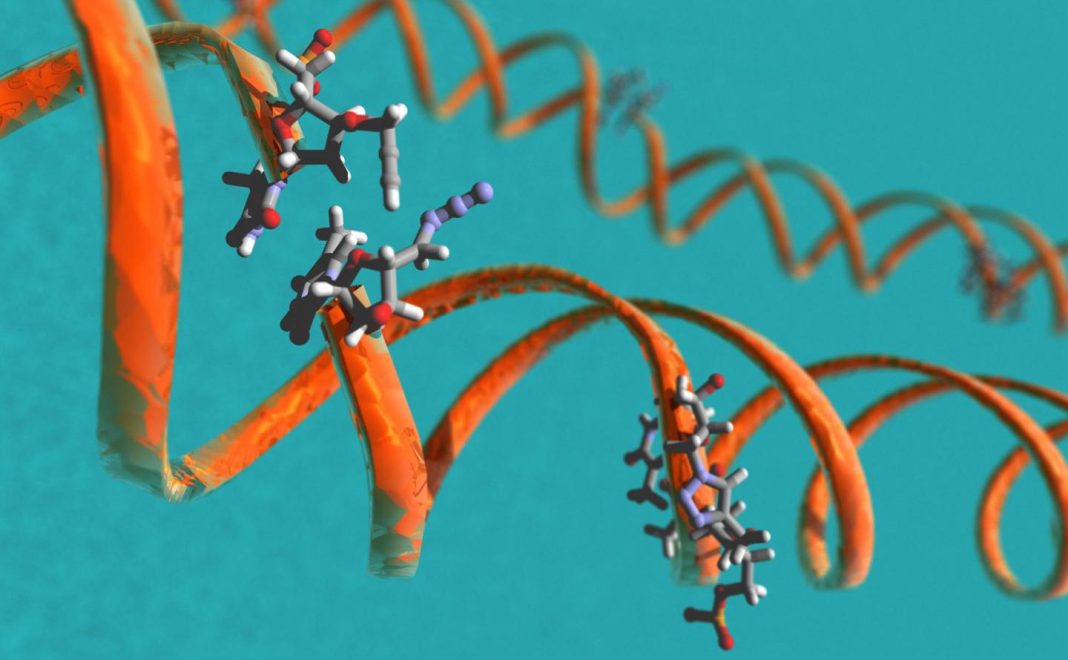Though “scarred” by chemical groups left behind by an artificial linker, DNA synthesized via click chemistry can still function in bacterial and human cells. Even better, as a new study demonstrates, the DNA retains site-specific epigenetic information in bacterial cells, which tends to be lost during the assembly of large DNA constructs. Preserving epigenetic information in synthesized DNA is important if such DNA is to contribute to our understanding of biological processes, such as cancer, that are influenced by epigenetically modified genes.
Current methods for synthesizing genes make extensive use of enzymes to connect short strands of DNA to form the larger strands that make up genes. These methods have been used to assemble very long DNA strands, such as an organism's genome, but are limited because of their reliance on enzymes. One of the main shortcomings is that they do not allow the incorporation into specific sites on the DNA of epigenetic information—a secondary layer of genetic information that controls the expression of genes in cells.
Piecing together large DNA constructs that preserve epigenetic information can be done, however, with a fully chemical “one pot” method that is being developed by scientists based at the University of Southampton. The scientists, led by Ali Tavassoli, Ph.D., call their method click-DNA ligation. It relies on a click chemistry reaction, specifically, the copper-catalyzed alkyne-azide cycloaddition reaction.
Using this reaction, the scientists synthesized the 335 base-pair gene that encodes the green fluorescent protein iLOV from 10 functionalized oligonucleotides that contain 5'-azide and 3'-alkyne units. Details of this work appeared September 11 in the journal Nature Chemistry, in an article entitled “Assembly of a Biocompatible Triazole-Linked Gene by One-Pot Click-DNA Ligation.”
“The resulting click-linked iLOV gene contains eight triazoles at the sites of chemical ligation, and yet is fully biocompatible; it is replicated by DNA polymerases in vitro and encodes a functional iLOV protein in Escherichia coli,” wrote the article’s authors. “We demonstrate the power and potential of our one-pot gene-assembly method by preparing an epigenetically modified variant of the iLOV gene.”
As in previous work, the scientists considered the scarring of the DNA backbone that results when click chemistry is used to cross-link DNA. While the click-DNA ligation can rapidly and efficiently stitch together modified DNA strands, it leaves behind a triazole groups in the DNA backbone at cross-linking sites.
Initially, the scientists feared that cellular machinery would be unable to read these unnaturally joined DNA strands. Yet research conducted three years ago by the University of Southampton team showed that click chemistry can be used to assemble DNA that is functional in bacterial and human cells.
“This is important because it shows that we don't have to stick to the phosphodiester backbone of the DNA at the site of DNA ligation,” Dr. Tavassoli said at the time. “This suggests that we can replace the enzymatic methods for DNA assembly and DNA ligation with highly efficient chemical reactions.”
The new study confirms this finding. Not only have we demonstrated assembly of a gene using click-chemistry,” asserted Dr. Tavassoli, “we have also shown that the resulting strand of DNA is fully functional in bacteria, despite the scars formed by joining fragments.”
The new study, besides confirming the biocompatibility of DNA synthesized via click chemistry, demonstrates that the new method can site-specifically incorporate epigenetic information into large synthetic constructs of DNA. The new chemical approach, the University of Southampton scientists insisted, also means that the synthesis of large DNA strands could be greatly accelerated and allow larger quantities of a single gene to be produced. It could also allow the process to become automated, potentially reducing the time and cost involved.
Study co-author Tom Brown, Ph.D., of the University of Oxford, who is also a visiting professor at the University of Southampton, commented: “The synthesis of chemically modified genes, which we have achieved by a radical new approach, will become ever more important as the effects of epigenetically modified DNA on gene expression become clear.
“We started the underpinning work on click ligation over 10 years ago, so it's very satisfying to now be at the stage where we can demonstrate this workable and highly effective new approach to gene synthesis.”


